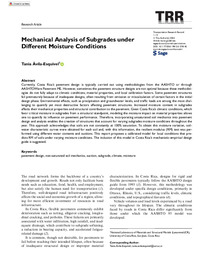Mechanical Analysis of Subgrades under Different Moisture Conditions
Abstract
Currently, Costa Rica’s pavement design is typically carried out using methodologies from the AASHTO or through
AASHTOWare Pavement ME. However, sometimes the pavement structure designs are not optimal because these methodologies
do not fully adapt to climatic conditions, material properties, and local calibration factors. Some pavement structures
fail prematurely because of inadequate designs, often resulting from omission or miscalculation of certain factors in the initial
design phase. Environmental effects, such as precipitation and groundwater levels, and traffic loads are among the most challenging
to quantify yet most destructive factors affecting pavement structures. Increased moisture content in subgrades
affects their mechanical properties and structural contribution to the pavement. Given Costa Rica’s climatic conditions, which
favor critical moisture in subgrades from a structural standpoint, modeling the moisture impact on material properties allows
one to quantify its influence on pavement performance. Therefore, incorporating unsaturated soil mechanics into pavement
design and analysis enables the creation of structures that account for varying subgrades moisture conditions throughout the
year. This approach acknowledges that soils are not constantly at 100% saturation. To obtain this moisture variation, soilwater
characteristic curves were obtained for each soil and, with this information, the resilient modulus (RM) test was performed
using different water contents and suctions. This report proposes a calibrated model for local conditions that predicts
RM of soils under varying moisture conditions. The inclusion of this model in Costa Rica’s mechanistic-empirical design
guide is suggested.
Collections
- Publicaciones [323]

